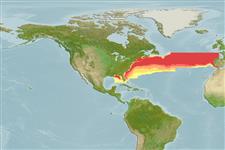Common names from other countries
Environment: milieu / climate zone / depth range / distribution range
экология
морской. Temperate; 48°N - 24°N, 89°W - 5°W
Western Atlantic: Nova Scotia in Canada to southern Florida in USA and eastern Gulf of Mexico (Ref. 7251). Eastern Atlantic: juveniles occasionally accompany floating objects across the Atlantic and have been recorded from Ireland, around the British Isles, off Portugal and the western Mediterranean.
Size / Вес / Возраст
Maturity: Lm ? range ? - ? cm
Max length : 91.0 cm TL самец/пол неопределен; (Ref. 7251); common length : 30.0 cm SL самец/пол неопределен; (Ref. 4542); наибольший вес (опубликованные данные): 12.3 kg (Ref. 7251)
Lives in deep water over continental slopes. Adults in submarine canyons, young more widely found in surface layers and may occur at times close inshore docks. Young to 30 cm common in large groups during summer and autumn under floating boards, boxes and barrels. Does not associate with medusae. Adults probably schooling in depths but not on the bottom. Feed on small fishes and crustaceans; also sqiud and molluscs (Ref. 5951). Probably a spring spawner. (see Ref 4542).
Life cycle and mating behavior
Maturities | размножение | Spawnings | Egg(s) | Fecundities | личинки
Bauchot, M.-L., 1987. Poissons osseux. p. 891-1421. In W. Fischer, M.L. Bauchot and M. Schneider (eds.) Fiches FAO d'identification pour les besoins de la pêche. (rev. 1). Méditerranée et mer Noire. Zone de pêche 37. Vol. II. Commission des Communautés Européennes and FAO, Rome. (Ref. 3397)
Статус Красного Списка МСОП (Ref. 130435)
CITES (Ref. 128078)
Not Evaluated
Угроза для людей
Harmless
Использование человеком
рыболовство: не имеет хозяйственного значения
дополнительная информация
инструменты
Специальные отчеты
Скачать в формате XML
ресурсы в Интернет
Estimates based on models
Preferred temperature (Ref.
115969): 5.7 - 19.7, mean 11.6 (based on 85 cells).
Phylogenetic diversity index (Ref.
82804): PD
50 = 0.5156 [Uniqueness, from 0.5 = low to 2.0 = high].
Bayesian length-weight: a=0.00891 (0.00406 - 0.01955), b=3.10 (2.91 - 3.29), in cm Total Length, based on LWR estimates for this (Sub)family-body shape (Ref.
93245).
Trophic level (Ref.
69278): 3.9 ±0.55 se; based on food items.
устойчивость к внешним воздействиям (Ref.
120179): низкий, минимальное время удвоения популяции 4.5-14 лет (Preliminary K or Fecundity.).
Fishing Vulnerability (Ref.
59153): High vulnerability (56 of 100).
